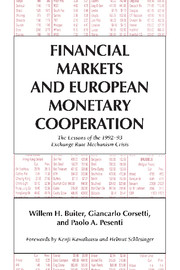 Financial Markets and European Monetary Cooperation
Financial Markets and European Monetary Cooperation Published online by Cambridge University Press: 06 July 2010
Introduction
In the central chapters of this book, most of our analysis of the European currency crisis was centered on the standard paradigms of a credibility game between a national policy maker and the private sector, and of strategic interaction among policy makers of different countries. In particular, we have built a novel interpretation of the 1992–93 events by developing a multicountry model of output and inflation stabilization with short-run nominal rigidities. Besides its application to the fall of the ERM, however, our theoretical construction has a number of additional implications for the design of a monetary union that are bound to be increasingly important as the final collective and individual decisions on EMU approach.
Following our discussion of the quest for exchange rate stability in Europe and our historical and analytical evaluation of the causes of the breakdown of the ERM in 1992–93, we now devote the final chapter of this book to the analysis of some key economic issues that have, so far, been only implicitly treated in our work. This involves a reexamination of the considerations that should guide the design of monetary, exchange rate, and fiscal policy by a group of nations considering monetary union and a brief discussion of a few issues in the transition to monetary unification. Much of it is a review of the theory of optimal currency areas, one of the murkiest and most unsatisfactory areas of macroeconomic and monetary theory.
To save this book to your Kindle, first ensure no-reply@cambridge.org is added to your Approved Personal Document E-mail List under your Personal Document Settings on the Manage Your Content and Devices page of your Amazon account. Then enter the ‘name’ part of your Kindle email address below. Find out more about saving to your Kindle.
Note you can select to save to either the @free.kindle.com or @kindle.com variations. ‘@free.kindle.com’ emails are free but can only be saved to your device when it is connected to wi-fi. ‘@kindle.com’ emails can be delivered even when you are not connected to wi-fi, but note that service fees apply.
Find out more about the Kindle Personal Document Service.
To save content items to your account, please confirm that you agree to abide by our usage policies. If this is the first time you use this feature, you will be asked to authorise Cambridge Core to connect with your account. Find out more about saving content to Dropbox.
To save content items to your account, please confirm that you agree to abide by our usage policies. If this is the first time you use this feature, you will be asked to authorise Cambridge Core to connect with your account. Find out more about saving content to Google Drive.